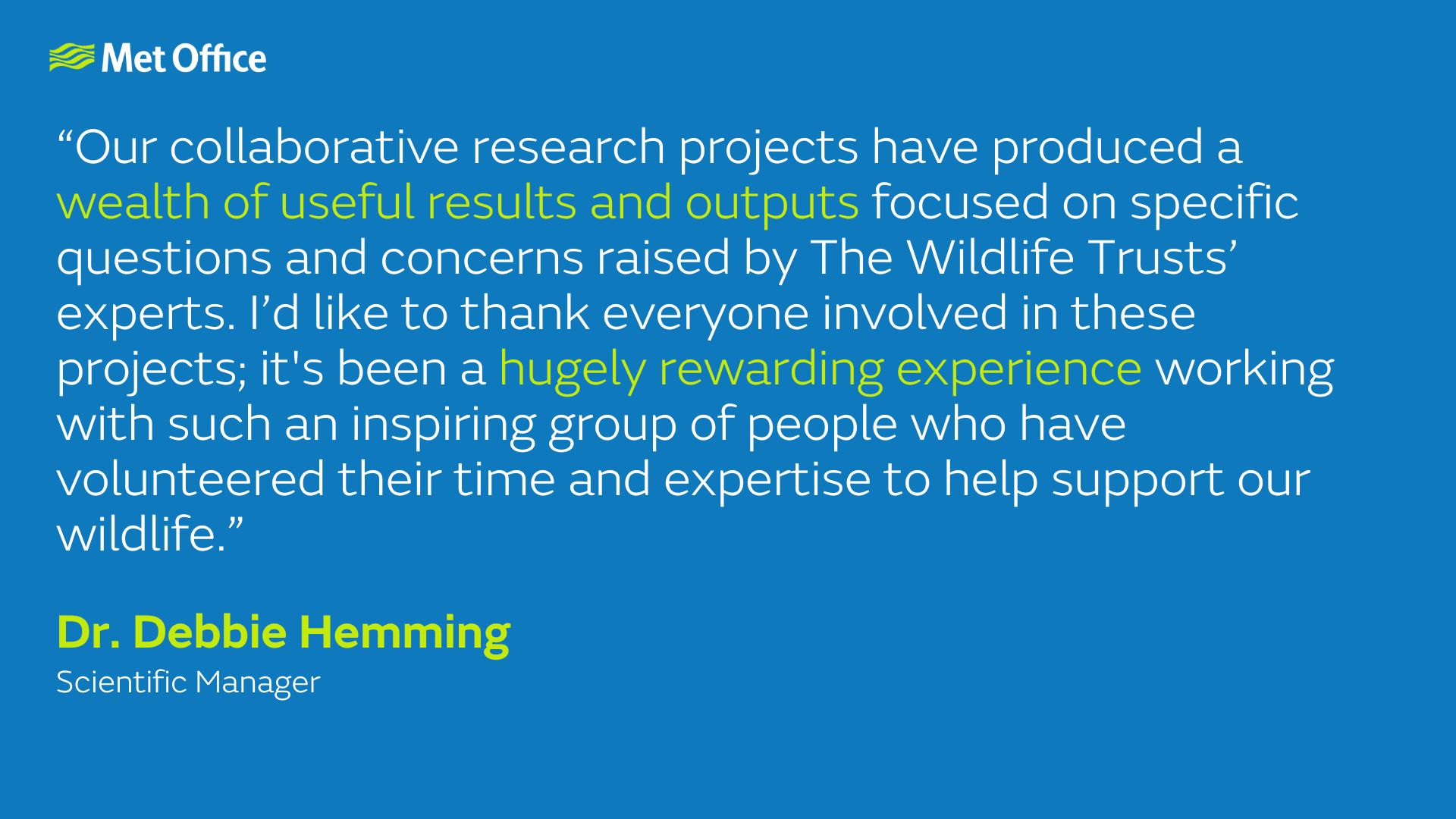Collaborating with The Wildlife Trusts
Over the past year we have worked on exciting and worthwhile research projects in partnership with The Wildlife Trusts, our corporate charity.
This partnership has allowed us to combine expertise and datasets from the Met Office and The Wildlife Trusts to focus on a wide range of weather and climate-related challenges faced by wildlife across the UK.
Staff at the Met Office were invited to volunteer their time and expertise to lead and drive forward the research in close collaboration with experts from across The Wildlife Trusts. The response was overwhelming, and we have had staff from many disciplines and backgrounds working for a year and a half on topics that were not necessarily their areas of expertise.
The work has helped build our understanding and raise awareness of the relationships between weather and climate and specific species or habitats of concern to The Wildlife Trusts.

As a result of our work together, we completed the following five separate projects:
- Project 1: Communicating current and future climate variations and changes
- Project 2: Developing weather and climate indicators
- Project 3: Pacific oysters and climate
- Project 4: Climate suitability for reintroducing rare plant species
- Project 5: Relationship between weather patterns and Barn owl numbers
Project 1: Communicating current and future climate variations and changes
Communicating how current climate variations and changes are affecting our wildlife, and how these are likely to change with future projected climate changes is a difficult task.
The project explored the major challenges posed by climate changes at Wildlife Trust sites and collated key points into four public-facing infographics focusing on peatlands, woodlands, coastal/saltmarsh sites and a general overview of climate-related challenges for wildlife and nature.
Project 2: Developing weather and climate indicators
Weather and climate influence our wildlife and habitats in many complex ways. Simple meteorological variables, such as daily average temperature, are often not the most appropriate for analysing these interactions.
This project developed weather and climate indicators of relevance for specific species or habitats at Wildlife Trust sites and assessed how these indicators have changed in the past and are projected to change in the future.
Project 3: Pacific oysters and climate
Over the past decade non-native and invasive Pacific oyster populations have boomed, primarily driven by warming sea temperatures due to climate change, and they are now threatening marine ecosystems in the UK. Although the growth in Pacific oyster numbers will have a positive impact on the economies of some areas, it will also have complex impacts on ecosystems and native species.
The project analysed current and future sea surface temperatures and how these relate to occurrence of the invasive Pacific oyster at Wildlife Trust sites.
Project 4: Climate suitability for reintroducing rare plant species
To increase the resilience of populations of some localised species, conservationists are considering moving or translocating species to former or new sites. The Meadow Clary (Salvia pratensis) is one such species which is currently in decline across the UK. The Wildlife Trusts wanted to explore reintroducing the species to sites that exhibit suitable current and future climate in the UK.
Using the Met Office’s HadUK-Grid climate data, this project assessed the suitability of the current and future climate across the UK for survival of Meadow Clary (Salvia pratensis). This is a perennial species that flowers from late May to early July and identify sites for potential reintroduction or introduction.
Project 5: Relationship between weather patterns and Barn owl numbers
Changing weather patterns, such as increasing rainfall, have the potential to affect some species, such as the Barn owl. Barn owls are perfectly adapted for silent flight; their feathers having a comb edge so the air flows through and they can surprise their prey. This unfortunately makes them unsuitable for flying in the rain. Ulster Wildlife have noted that the nesting success of Barn owls in Northern Ireland reached a recent low, and there has been an increase in variability in the timings of nesting in recent years.
This project explored relationships between recent weather and climate variations and the nesting success of Barn owls in Northern Ireland and showed that higher than normal rainfall in key months was indeed one of the main factors associated with poor nesting survival.
Outputs
Each of these projects created various outputs based on their research, which can be viewed below. If you would like to find out more about any of these projects, you can contact Debbie Hemming ([email protected]).
| Projects | Outputs |
|---|---|
| Project 1 | WT-MO Project 1 Outputs |
| Project 2 | WT-MO Project 2 Outputs |
| Project 3 | WT-MO Project 3 Outputs |
| Project 4 | WT-MO Project 4 Outputs |
| Project 5 | WT-MO Project 5 Outputs |
You can find out more about the background of our joint research in collaboration with The Wildlife Trusts in our research news release.




